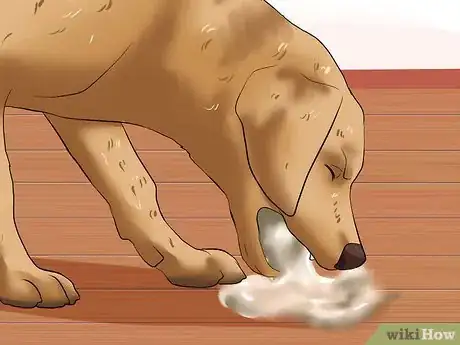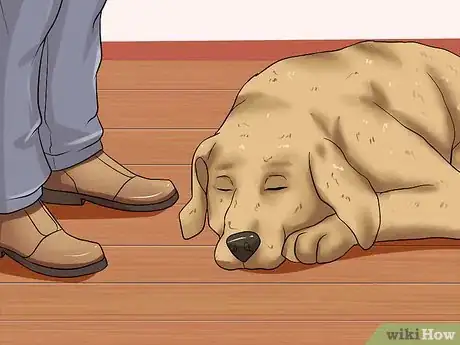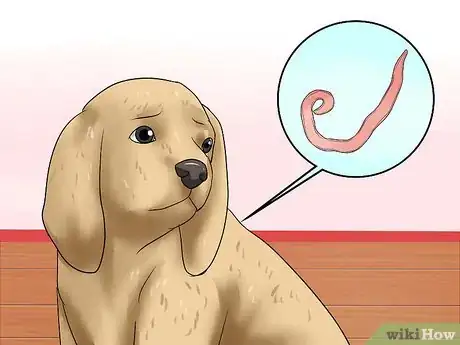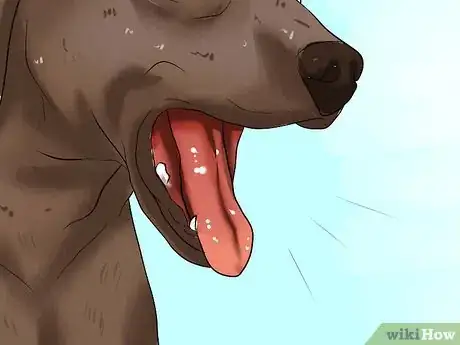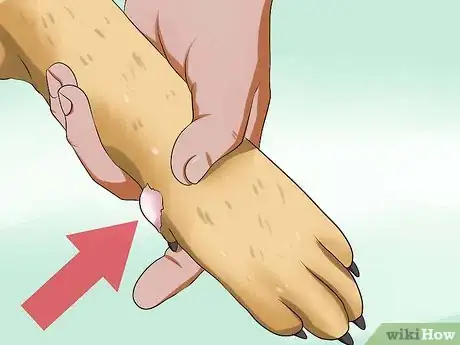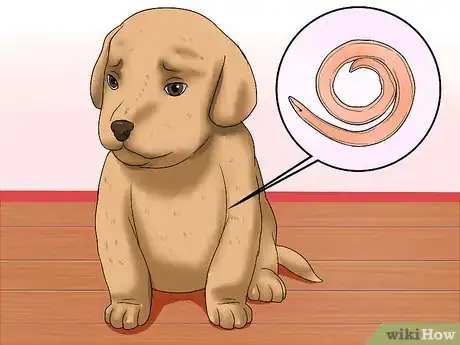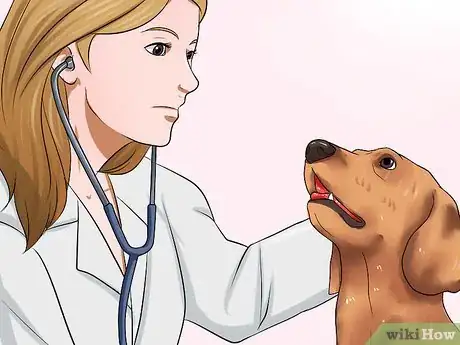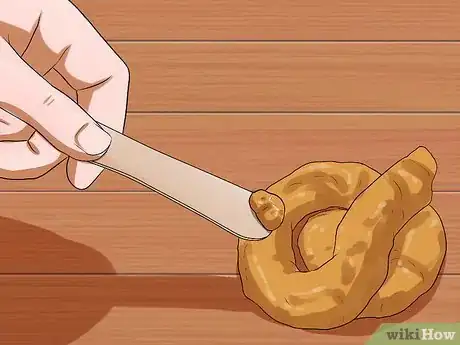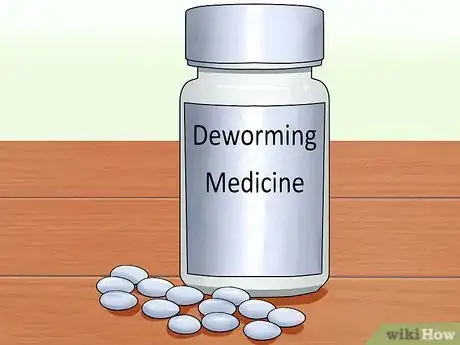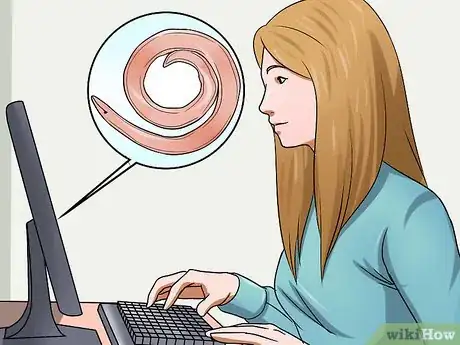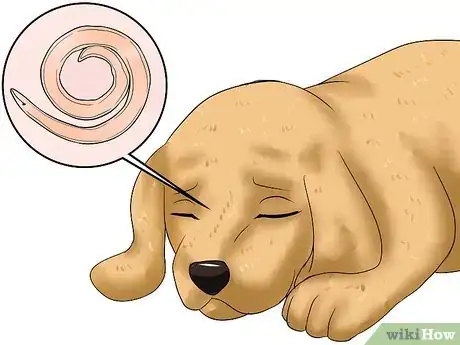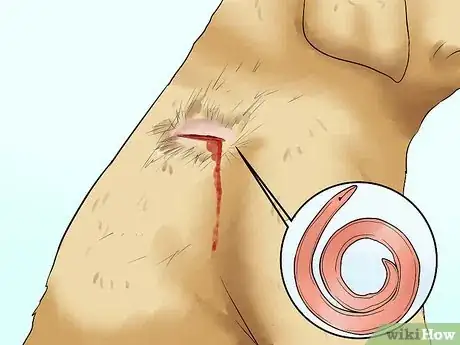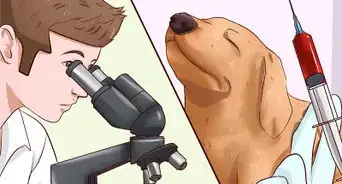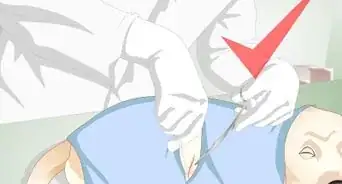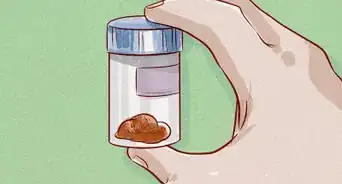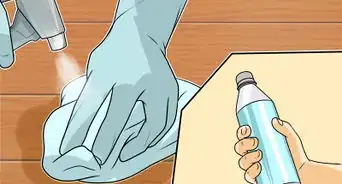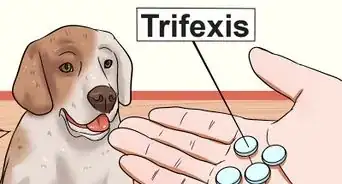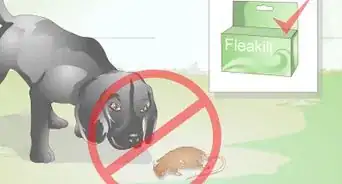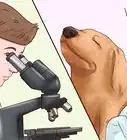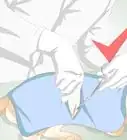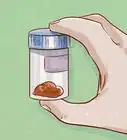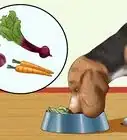This article was co-authored by Pippa Elliott, MRCVS. Dr. Elliott, BVMS, MRCVS is a veterinarian with over 30 years of experience in veterinary surgery and companion animal practice. She graduated from the University of Glasgow in 1987 with a degree in veterinary medicine and surgery. She has worked at the same animal clinic in her hometown for over 20 years.
This article has been viewed 69,205 times.
Hookworms are an internal parasite that infects dogs and can cause serious internal bleeding. They are a common in dogs but puppies are especially at risk of infection.[1] However, effective anti-parasitic medications are available that kill this parasite. In order to get your dog this treatment, you should be vigilance about looking for the signs of infection and getting a prompt diagnosis from your vet.
Steps
Identifying the Symptoms of a Hookworm Infection
-
1Be on the lookout for diarrhea or vomiting. A hookworm bites into the bowel wall, which can cause pain and stomach cramps. The dog is also likely to have diarrhea that is tinged with blood.[2]
- Also, if there is bleeding into the bowel, by the time the blood have passed along the gut it gives the feces a dark color.
- Some dogs may also vomit from hookworms, and this could contain blood as well.
-
2Look for signs of anemia. The blood lost into the bowel, or consumed by hookworms, can cause anemia in the host. This blood loss causes the dog to lack energy and seem extremely tired. The anemia can also become life threatening in cases of hookworm that are left untreated.[3]
- If you lift a healthy dog's lip, the mucous membrane lining the mouth should be a healthy pink color. However, in an anemic dog the gums are a pale pink or even a white color.
Advertisement -
3Be suspicious of stunted growth in puppies. In puppies with a heavy infection, the hookworms rob the puppy of nutrition. This causes the pup to grow poorly and its coat is likely to have a dull, harsh texture and color.[4]
- However, puppies can have stunted growth for a variety of reasons. If your puppy does not seem to be growing in size, take it to its veterinarian to get checked out.
-
4Pay attention to coughs. The larvae migrate to the lungs where they are coughed up and swallowed down into the gut to mature. Therefore you may notice your dog has an intermittent cough.
-
5Notice if your dog has itchy, irritated feet. A dog that was kept in unsanitary conditions may have been subject to larvae migrating through the skin of its paws. This causes intense irritation, so the dog is liable to chew and bite at its feet.[5]
- Remember, though, that this is not the only way that hookworms enter the body, so a dog infected with them will not necessarily have irritated feet.
-
6Be very suspicious of symptoms in puppies that have not been treated for worms. Puppies should be treated for worms starting at two weeks old, with additional doses every two weeks for two months.[6] If your puppy has not gotten these treatments then it is more likely that it has worms.
- If you got your puppy from a good animal rescue or humane society, they should have at least begun its deworming.
- If you got your dog from an unverified source, such as from an online want-ad listing, then it may not have had any deworming treatments and is at risk of infection.
Getting a Medical Diagnosis of Hookworm Infection
-
1Take your dog to the vet. If you notice some of the signs of a hookworm infection then you should get your dog checked out by a vet. The vet will perform a thorough physical examination to assess the patient, paying attention to what symptoms the dog has and how severe they are.
-
2Bring a stool sample with you. If the veterinarian suspects a hookworm infection, a diagnosis can be confirmed on a fecal flotation test. This is a special test where a sample of feces is mixed with a special solution and the hookworms eggs float to the surface. This is because the hookworm eggs are less dense than the fluid and the feces.[7]
- A clean microscope slide is then touched to the surface of the special solution and any eggs present stick to the slide. This is then examined under the microscope for the presence of hookworm eggs.
- This test is liable to detect a positive hookworm infection because hookworms pass large numbers of eggs that are shed regularly.
- The only time it is less reliable is in very young pups when the larvae have yet to mature into the adult form and therefore no eggs have been produced. This usually takes around 2 weeks, so if one negative test was obtained, a second test 2 - 3 weeks later should prove positive if the pup is infected.
-
3Follow your veterinarian's suggestions for treatment. The good news is that hookworms can be killed with a wide variety of deworming medications. However, these are only effective against adult worms, so it is a good idea to repeat dose the dogs 2 - 4 weeks after the initial dose.[8]
- Because of the greater risk of puppies being infected, it is advisable to treat them at 2,4,6, and 8 weeks of age with a product suitable for use at this age, such as fenbendazole (Panacur or Safeguard).[9]
Understanding Hookworms
-
1Learn about hookworms. The scientific name for hookworms is Ancylostoma. They are a small, almost microscopic worm, with the adults being a maximum of 3mm long. They are rarely noticeable in a dog's feces because of their small size, and because they grip tightly onto the bowel wall, so they are not passed in large numbers.[10]
- Hookworms are commonly found throughout North America.[11]
- The adult worms live in the host's small intestine where they anchor themselves to the gut wall with hook-like mouths. The appearance of their mouths under a microscope is why they are named hookworms.
-
2Understand how hookworms infect dogs. There are several ways that dogs can get hookworms. Dogs can be infected while they are growing in their mother's womb or are nursing, by licking contaminated feces, and through the skin of their paws.
- Unfortunately, hookworm infection is prevalent in puppies. This happens because hookworm larvae that are dormant in the mother can become activated when she is pregnant, migrate to the uterus, and infect the puppies in the womb.
- Also, the larvae migrate to the mammary glands where they are excreted in the mother's milk to infect the pups when they are suckling.[12]
- Dogs can also be infected orally if they lick feces contaminated with hookworm eggs. This is likely to happen if groups of dogs are kept in dirty conditions or they walk through feces and then lick their paws clean.
- Dogs can also be infected when larvae migrate through the skin on their paws. Again, this is caused by living in unhygienic conditions and being exposed to contaminated feces.[13]
-
3Figure out why hookworms are bad for your dog. Hookworms suck your dog's blood, leading to blood loss.[14] One of the reasons that the blood loss is so extreme is because hookworms inject an anticoagulant through their mouths that stops a dog's blood from clotting. This means the dog then bleeds continually from the bite mark, even if the parasite let's go and relocates.
- This blood loss can be life threatening for puppies, and make a full-sized dog chronically ill.
- Hookworms can also cause your dog to have diarrhea and weight loss.
References
- ↑ http://www.vcahospitals.com/main/pet-health-information/article/animal-health/hookworm-infection-in-dogs/785
- ↑ http://www.peteducation.com/article.cfm?c=2+2090&aid=747
- ↑ http://www.vcahospitals.com/main/pet-health-information/article/animal-health/hookworm-infection-in-dogs/785
- ↑ https://www.cesarsway.com/dog-care/other-worms/symptoms-of-worms-in-dogs
- ↑ http://www.peteducation.com/article.cfm?c=2+2111&aid=423
- ↑ http://www.petsandparasites.org/dog-owners/hookworms/
- ↑ http://www.vcahospitals.com/main/pet-health-information/article/animal-health/hookworm-infection-in-dogs/785
- ↑ http://www.vcahospitals.com/main/pet-health-information/article/animal-health/hookworm-infection-in-dogs/785
- ↑ http://www.petsandparasites.org/dog-owners/hookworms/
About This Article
To diagnose hookworms in your dog, watch for symptoms, like diarrhea and vomiting that's tinged with blood. Additionally, check your dog’s gums to see if they’re pale pink or white, which may indicate the worms have caused your dog to develop anemia. You may also notice that your dog has an intermittent cough, which is a sign that the worms have migrated to its lungs. If you see any of these symptoms in your dog, contact your vet right away since hookworms can be fatal, especially in puppies. For more advice from our Veterinary co-author, including how to treat your dog for hookworms, keep reading.
